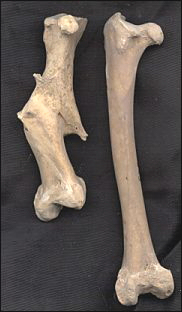

There's lots in the news about osteoporosis—the loss of bone mass to the point that bones break easily. Which emphasizes what few people realize about bones—they aren't just inert hunks of mineral, but complex, biologically active structures. The seemingly stable skeleton of the body is constantly reworked throughout life—for better and for worse.
Bone includes living cells continually dissolving and depositing minerals in response to the stresses of muscles and gravity. A protein framework ramifying throughout supplies some flexibility, discouraging shattering of the brittle mineral matrix. With much of the skeleton constructed of minerals, the body treats it as a storehouse, especially for the calcium so vital for the processes of life. As blood calcium levels ebb and flow, bone is dissolved and added according to need. With age and calcium deficiency, outgo dominates, and osteoporosis follows.
Skeletons recovered from within the Chihuahuan Desert too often reveal
an array of physical and dietary stresses, from healed fractures to starvation-induced
pathologies. The desert has its charms, but an easy life is not one of them.

Contributor: Arthur H. Harris, Laboratory for Environmental Biology, Centennial Museum, University of Texas at El Paso.
Desert Diary is a joint production of the Centennial Museum and KTEP National Public Radio at the University of Texas at El Paso.

Femurs of two domestic turkeys recovered from one of the Rio Grande pueblos. The femur on the left had been badly shattered, but the bird survived. Normal femur on the right for comparison. A number of broken bones have been recovered from the site, suggesting that young birds sometimes ended up underfoot. Scanned images by A.H. Harris.